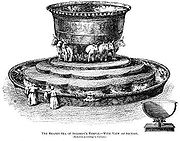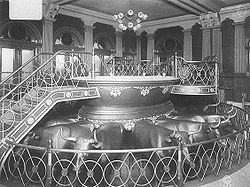
Molten Sea
Encyclopedia

Temple in Jerusalem
The Temple in Jerusalem or Holy Temple , refers to one of a series of structures which were historically located on the Temple Mount in the Old City of Jerusalem, the current site of the Dome of the Rock. Historically, these successive temples stood at this location and functioned as the centre of...
made by Solomon
Solomon
Solomon , according to the Book of Kings and the Book of Chronicles, a King of Israel and according to the Talmud one of the 48 prophets, is identified as the son of David, also called Jedidiah in 2 Samuel 12:25, and is described as the third king of the United Monarchy, and the final king before...
for ablution of the priests. It is described in and . It stood in the south-eastern corner of the inner court. According to the Bible it was five cubits high, ten cubits in diameter from brim to brim, and thirty cubits in circumference. It was placed on the backs of twelve oxen, standing with their faces outward. It was capable of containing two or three thousand baths of water. Though some think this impossible or unlikely based upon the stated dimensions, the fact that it was a wash basin which was too large to enter from above lends to the idea that water would likely have flowed from it down into a subcontainer beneath. . The water was originally supplied by the Gibeonites, but was afterwards brought by a conduit from the pools of Bethlehem. The molten sea was made of "brass" (copper), which Solomon had taken from the captured cities of Hadarezer, the king of Zobah
Zobah
Zobah or Aram-Zobah was the capital of an early Aramean state in southern Syria, at one time of considerable importance. In I Samuel xiv...
. Ahaz
Ahaz
Ahaz was king of Judah, and the son and successor of Jotham. He is one of the kings mentioned in the genealogy of Jesus in the Gospel of Matthew....
later removed this laver from the oxen, and placed it on a stone pavement . It was destroyed by the Chaldeans .
In Rabbinical Literature
The basin as contained water sufficient for 150 ritual baths (mikvahMikvah
Mikveh is a bath used for the purpose of ritual immersion in Judaism...
). According to the Talmud the laver was not entirely round, as might be inferred from Scripture the upper two-fifths were round; but the lower three were square (Talmud
Talmud
The Talmud is a central text of mainstream Judaism. It takes the form of a record of rabbinic discussions pertaining to Jewish law, ethics, philosophy, customs and history....
Eruvin 14a, b).
The symbolism of the brazen sea is described in detail in the Midrash Tadshe
Midrash Tadshe
Midrash Tadshe is a small midrash which begins with an interpretation of Gen. i. 11:The name of the author occurs twice , and the midrash closes with the words "'ad kan me-dibre R. Pineḥas ben Ya'ir." No other authors are named...
. The sea represented the world; the ten ells of diameter corresponded to the ten Sefirot; and it was round at the top (according to the Talmud passage above cited) as the heavens are round. The depth of the sea was five ells, corresponding to the distance of five hundred years' journey between heaven and earth (compare Chagigah 13a). The band of thirty ells around it corresponded to the Ten Commandments, to the ten words of God at the creation of the world, and to the ten Sefirot: for the world can exist only when the Ten Commandments
Ten Commandments
The Ten Commandments, also known as the Decalogue , are a set of biblical principles relating to ethics and worship, which play a fundamental role in Judaism and most forms of Christianity. They include instructions to worship only God and to keep the Sabbath, and prohibitions against idolatry,...
are observed; and the ten Sefirot as well as the ten words of God were the instruments of the Creation. The two rows of colocynths (knops) below the rim were symbolic of the sun and the moon, while the twelve oxen on which the sea rested represented the zodiac ("mazzalot
Hebrew astronomy
Hebrew astronomy refers to any astronomy written in Hebrew or by Hebrew speakers, or translated into Hebrew. It also includes an unusual type of literature from the Middle Ages: works written in Arabic but transcribed in the Hebrew alphabet...
"). It contained 2,000 baths (cubic measures), for the world will sustain him who keeps the Torah, which was created 2,000 years before the world (Midrash Tadshe ii., ed. Epstein, in "Mi-Ḳadmoniyot ha-Yehudim," xvi., xvii.; Yalḳuṭ, Kings, 185)
The Laver of the Tabernacle
In the Priestly CodePriestly Code
The Priestly Code is the name given, by academia, to the body of laws expressed in the Torah which do not form part of the Holiness Code, the Covenant Code, the Ritual Decalogue, or the Ethical Decalogue. The Priestly Code constitutes the majority of Leviticus, as well as some of the laws...
of Exodus, instead of the Molten Sea is described a bronze laver, which was to rest on a bronze foot (presumably just meaning a stand). In a later part of the Priestly Code, in the passage describing the actual creation of the Temple furniture, it is claimed that this laver and its foot were made from the mirrors of the Israelite
Israelite
According to the Bible the Israelites were a Hebrew-speaking people of the Ancient Near East who inhabited the Land of Canaan during the monarchic period .The word "Israelite" derives from the Biblical Hebrew ישראל...
women; Julius Wellhausen
Julius Wellhausen
Julius Wellhausen , was a German biblical scholar and orientalist, noted particularly for his contribution to scholarly understanding of the origin of the Pentateuch/Torah ....
regarded this particular detail as a haggadic addition.
The text explains that this laver was to be used for the Israelite priests
Kohen
A Kohen is the Hebrew word for priest. Jewish Kohens are traditionally believed and halachically required to be of direct patrilineal descent from the Biblical Aaron....
to wash their hands and feet when they entered the sanctuary.
The size and shape of this laver are not mentioned anywhere in the Bible, and nor are those of its stand, unlike the case for the Molten Sea. By contrast, the special golden candlestick is described by the Priestly Code, but not in the description of Solomon's temple. It might therefore be the case that the laver and the candlestick are somehow the same object.
Relation to Solomon's platform
Solomon is described by the Book of Chronicles as having constructed a special platform in his Temple, for him to use during the opening ceremony. Although it is often assumed that the text describes Solomon as standing on this platform, the text could equally be read stood next to.This platform is literally described by the masoretic text
Masoretic Text
The Masoretic Text is the authoritative Hebrew text of the Jewish Bible and is regarded as Judaism's official version of the Tanakh. While the Masoretic Text defines the books of the Jewish canon, it also defines the precise letter-text of these biblical books, with their vocalization and...
as a laver (Hebrew: kiyyor), and as with the Priestly Code's laver, there is only one platform, and it is placed in the centre of the outer court. The Septuagint calls it a base, and the size of the brazen platform is the same as that of each base for the ten Brazen Laver
Brazen Laver
The ten Brazen Lavers were bronze lavers utilised in the Temple of Solomon, in addition to the Molten Sea, according to the Book of Kings.All this passage explains about the lavers themselves is their size, and that they were made from bronze...
s.
It is therefore quite possible that the account of this platform in the Book of Chronicles is actually an account of a laver corresponding to the laver of the Priestly Code.
Mormon interpretation

Mormonism
Mormonism is the religion practiced by Mormons, and is the predominant religious tradition of the Latter Day Saint movement. This movement was founded by Joseph Smith, Jr. beginning in the 1820s as a form of Christian primitivism. During the 1830s and 1840s, Mormonism gradually distinguished itself...
believe that the molten sea in Solomon's Temple was a baptismal font
Baptismal font
A baptismal font is an article of church furniture or a fixture used for the baptism of children and adults.-Aspersion and affusion fonts:...
. As explained by apostle Bruce R. McConkie
Bruce R. McConkie
Bruce Redd McConkie was a member of the Quorum of the Twelve Apostles of The Church of Jesus Christ of Latter-day Saints from 1972 until his death...
:
In Solomon’s Temple a large molten sea of brass was placed on the backs of 12 brazen oxen, these oxen being symbolical of the 12 tribes of Israel. This brazen sea was used for performing baptisms for the living. There were no baptisms for the dead until after the resurrection of Christ.
It must be remembered that all direct and plain references to baptism have been deleted from the Old Testament (1 NephiFirst Book of NephiThe First Book of Nephi is the first book of the Book of Mormon. Its full title is The First Book of Nephi: His Reign and Ministry. The book is usually referred to as First Nephi and abbreviated as "1 Ne.". It is a first-person narrative, beginning around 600 BC, of a prophet named Nephi...
13) and that the word baptize is of Greek origin. Some equivalent word, such as wash, would have been used by the Hebrew peoples. In describing the molten sea the Old Testament record says, "The sea was for the priests to wash in." (2 Chron. 4:2–6). This is tantamount to saying that the priests performed baptisms in it.
Every temple
Temple (LDS Church)
In The Church of Jesus Christ of Latter-day Saints , a temple is a building dedicated to be a House of the Lord, and they are considered by Church members to be the most sacred structures on earth. Upon completion, temples are usually open to the public for a short period of time...
of The Church of Jesus Christ of Latter-day Saints (LDS Church) contains a baptismal font on twelve oxen that is modeled after the molten sea. The LDS Church performs baptisms for the dead
Baptism for the dead
Baptism for the dead, vicarious baptism or proxy baptism is the religious practice of baptizing a living person on behalf of one who is dead, with the living person acting as the deceased person's proxy...
in these fonts.

